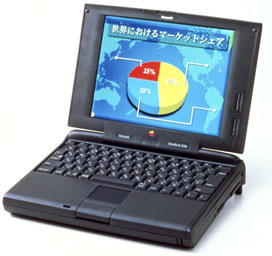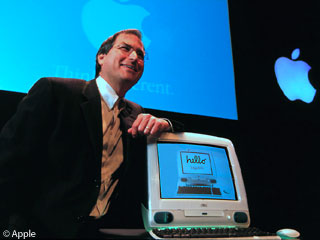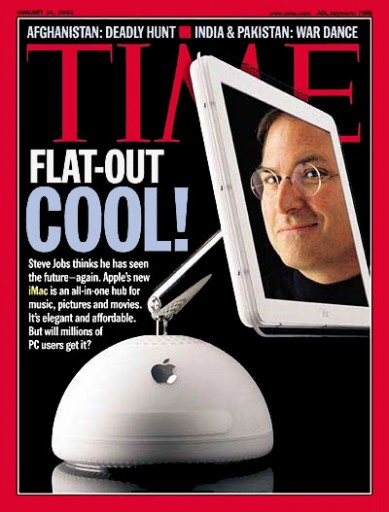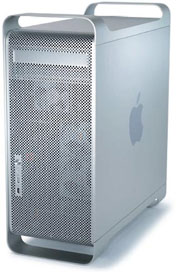Although the World Wide Web had been created many years earlier, it was in 1995 that it rocketed into public view. Window 95 shipped in August, and Intel unveiled the Pentium Pro in November. Apple used the new PowerPC 603 CPU in its Performa 5200 and 6200 models, both running at 75 MHz. The 603 was designed for consumer machines, but its tiny 8 KB Level 1 cache made it run legacy 680×0 code very poorly, and Apple refused to put the original 603 in any of its PowerBooks.
 Once the PowerPC 603e was available with a larger (16 KB) L1 cache, Apple released the PowerBook 5300 and PowerBook Duo 2300c. The 603e was the first mainstream desktop CPU to reach the 300 MHz mark, and a radiation hardened version is still being sold for use in satellites and a later version was used in the Mars Rover (see Macs in Space: Curiosity Rover Based on G3 Processor).
Once the PowerPC 603e was available with a larger (16 KB) L1 cache, Apple released the PowerBook 5300 and PowerBook Duo 2300c. The 603e was the first mainstream desktop CPU to reach the 300 MHz mark, and a radiation hardened version is still being sold for use in satellites and a later version was used in the Mars Rover (see Macs in Space: Curiosity Rover Based on G3 Processor).
The PowerPC 604 was used in professional Macs, starting with the 120 and 132 MHz Power Mac 9500 in April 1995. The 604 was the first PowerPC processor designed for multiprocessing, and in some cases, it was used in quad-processor systems.
And that brings us to licensed Mac clones. Radius was first to market, Power Computing was the first with a license, and DayStar Digital was the first with a multi-processor Mac OS computer – some model had four! DayStar went on to license its technology to Apple, which used it in some high-end dual-processor Power Macs running PowerPC 604 and 604e CPUs.
Something almost completely new arrived in March 1996, the first Palm Pilot devices. They were like Newtons, but a whole lot smaller and lighter, and it sold in much greater numbers. Like Apple, Palm would eventually license its OS, and to almost equally devastating results.
Microsoft launched Windows NT 4.0 in July 1996. Also in 1996, Apple acquired NeXT and brought Steve Jobs back to the company he had founded. One of his early decisions was to end the cloning, which was eating away at the most profitable part of Apple’s hardware business.
The Pentium II and Pentium MMX arrived in 1997. Be Inc. began porting its BeOS to Intel hardware in 1997, 56k* modems took the industry by storm, and the first cable modems shipped. Apple introduced Mac OS 8.0 in 1997.
In November 1997, Apple shipped the Power Mac G3 and PowerBook G3, the world’s fastest laptop computer of its day. The Power Mac G3 was available in desktop, mini-tower, and all-in-one versions, and Apple became the second major company to sell build-to-order computers online using its new online store. (Prior to this, Dell was the only major company selling build-to-order PCs.)
Windows 98 shipped in mid-1998, and Intel unveiled its low-cost Celeron CPU the same year. On the Apple side of things, the WallStreet PowerBook G3 showed just how expandable a notebook could be with two device bays, a SCSI port, two PC Card slots, up to a 14″ 1024 x 768 screen, and a swoopy new case.
 Also in 1998, the iMac helped push USB as the eventual successor to the parallel and serial ports common on Windows PCs, also displacing every legacy connection on the Mac except for ethernet.
Also in 1998, the iMac helped push USB as the eventual successor to the parallel and serial ports common on Windows PCs, also displacing every legacy connection on the Mac except for ethernet.
Apple redesigned the Power Mac G3 in a new, iMac-inspired blue and white enclosure, which debuted in January 1999. Apple’s pro line lost built-in SCSI, retained one ADB port, and gained both USB and FireWire. In May a new generation of thinner, light PowerBook debuted, Lombard, the first PowerBook with USB. At the end of August, Apple introduced the Power Mac G4, the most powerful computer on the planet and powerful enough to fall under export restrictions.
The Pentium III arrived on the scene in 1999, as did the AMD Athlon, which became locked in a MHz war (and soon a GHz war) with Intel. The Athlon reached 800 MHz by the end of the year and was first past the 1 GHz mark in 2000. Apple released Mac OS 9 in October 1999.
2000 was also the year Microsoft released Windows 2000, the successor to Windows NT, and also tweaked Windows 98 to create Windows Me (Millennium Edition), the last version of Windows in the Windows 9x family. Apple took the PowerBook to the next level with Pismo, which dropped SCSI in favor of FireWire and shared the same device bay modules as Lombard.
 In July 2000, Apple introduced one of the most beautiful computers ever, the Power Mac G4 Cube.
In July 2000, Apple introduced one of the most beautiful computers ever, the Power Mac G4 Cube.
Apple began 2001 with its new Titanium PowerBook G4, which gave up device bays and curves for a 1″ thin design and a widescreen 1152 x 768 pixel 15″ display. In March 2001, Apple delivered Mac OS X 10.0, showing off the new powerful operating system but mostly dependent on Classic Mode to run software designed for Mac OS 9. It would take a couple years before the bulk of software had been rewritten for Mac OS X.
In 2001 Intel shipped the Pentium 4, a processor theoretically more powerful than the Pentium III that tended to turn in lower performance ratings at the same MHz speed. The first Pentium 4 ran at 1.4 GHz, and by September Intel was selling 2 GHz P4s. In terms of marketing, the MHz number was more important than how powerful the processor actually was. During the summer of 2001, Intel finally began shipping its oft-delayed Itanium processor, designed as a 64-bit successor to the aging x86 architecture, itself designed as a successor to the 8-bit 8080 processor of 1975.
Mac OS X 10.1 arrived in Sept. 2001 as a free update to 10.0. And in August 2002, Mac OS X 10.2 Jaguar arrived, which many consider the version that was finally ready for prime time.
 Apple began 2002 with the flat-panel iMac G4, a machine so stunning that it made the cover of TIME magazine.
Apple began 2002 with the flat-panel iMac G4, a machine so stunning that it made the cover of TIME magazine.
In January 2003 Apple introduced two new PowerBook models with aluminum enclosures, a compact 12″ PowerBook G4 and a pro-oriented 17″ PowerBook G4. They were joined by a 15″ aluminum model in Sept.
 In June 2003, Apple introduced a new line of Power Mac computers using IBM’s newest PowerPC, the 970 – also known as the G5. The Power Mac G5 introduced a new design with a much faster data bus, USB and FireWire ports on the front for easy access, and the new SATA bus for hard drives.
In June 2003, Apple introduced a new line of Power Mac computers using IBM’s newest PowerPC, the 970 – also known as the G5. The Power Mac G5 introduced a new design with a much faster data bus, USB and FireWire ports on the front for easy access, and the new SATA bus for hard drives.
Microsoft released its next-generation Windows version in late 2003, Windows XP, which merged the consumer Windows 9x family and the Windows NT family. Windows XP was the biggest thing that ever happened to Windows with at least 400 million licensed copies, and although its successor, Vista, shipped in 2007, users still clamored for XP.
October 2003 also saw the debut of Mac OS X 10.3 Panther, an even smoother, more polished operating system.
Intel introduced the Pentium M in 2003, a low-power version of the Pentium III intended for notebook computers. The Pentium M family eventually resulted in the Core Duo CPUs that were used in most first generation Intel-based Macs – but that’s a story for the next chapter. This was also the year that AMD brought forth the first 64-bit x86 processors, the Opteron and the Athlon 64. AMD’s x86-64 architecture was so influential that Intel adopted it and began using it in 2004.
The iMac got a facelift and brain transplant in August 2004 with the introduction of the 17″ iMac G5. The new design that put the entire computer behind the screen has remained a staple of the iMac ever since.
* As explained on the No Hype 56k Modem Page, these modems could theoretically reach 56 kbps, were limited by the FCC in the United States to 53 kbps, and commonly connected somewhere in the low-to-mid-40s. Still, that was faster than the old 28.8 and 33.6 kbps modems – and most users never realized that what they gained in download speed (up to 56k) came at the expense of upload speed, which was still limited to 33.6 kbps and decreased as download speeds increased when both processes were taking place concurrently.
Personal Computer History Index: 1975-84, 1985-94, 1995-2004, 2005-14, 2015-Present
Keywords: #pchistory #personalcomputinghistory
Short link: https://goo.gl/YYnMNa
searchword: pchistory

